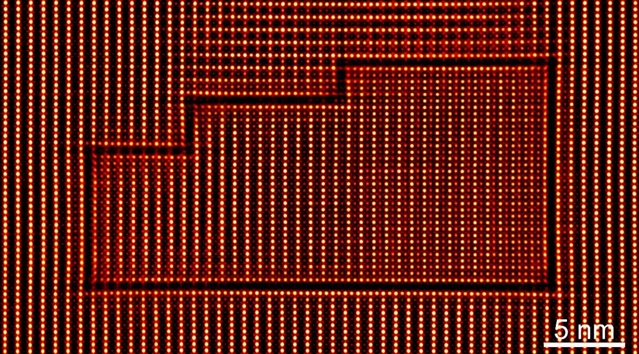Toggle Navigation
单壁锂阱:围困锂离子的单原子层壁垒 | Nature Communications
论文标题:Single-atom-layer traps in a solid electrolyte for lithium batteries
期刊: Nature Communications
作者:Feng Zhu, Md Shafiqul Islam et.al
发表时间:2020/04/14
数字识别码:10.1038/s41467-020-15544-x
微信链接:点击此处阅读微信文章
Nature Communications近期发表的一项研究Single-atom-layer traps in a solid electrolyte for lithium batteries表明,一种在固态电解质研究中不曾被考虑过的非周期性结构——单壁锂阱(single-atom-layer trap, SALT),可以像晶界、点缺陷等受到普遍关注的非周期性结构一样对锂离子传输产生重要影响。
全固态锂电池因其在安全性和能量密度上的双重优势受到广泛关注,而成功构筑这一电池的关键在于合成离子传输性能优异的固态电解质。为了实现这个目标,研究者必须充分地理解锂离子在材料中的传输机理。在固态电解质中,偏离理想晶体结构的“非周期性结构”往往可以极大地抑制或促进锂离子的传输,甚至能导致离子电导率发生几个数量级的改变。因此,为了全面的理解离子传输机理,必须先充分研究这些能剧烈影响离子传输的非周期性结构。

图1:单壁锂阱的原子像
在以往的机理研究中,受到普遍关注的非周期性结构主要包括晶界和点缺陷两大类,而中国科学技术大学的马骋教授和美国马里兰大学的莫一非教授发现了另一类能显著影响离子传输的非周期性结构。通过球差校正透射电镜对经典固态电解质Li0.33La0.56TiO3的观测,作者发现了大量单原子层缺陷。不同于晶界、层错等非周期性结构,这些缺陷相当于一层外延生长在Li0.33La0.56TiO3上的单原子层第二相。由于这种外延生长只发生在特定的晶体学取向,大部分单原子层缺陷会相互连通,进而形成闭合的环。结合电镜观测和理论计算,作者发现尽管组成闭环的缺陷只有一个原子层厚,但它们特殊的结构可以彻底阻止锂离子穿过缺陷所在的平面。因此,当这些缺陷形成闭环时,锂离子将无法进出被封闭的体积,从而使得这部分材料并不能参与整体的锂离子传输,就像陶瓷中因无法充分致密化而残留的孔隙一样。大量电镜观测结果表明这种缺陷环在样品中普遍存在,其影响等同于增加约15.1 vol%的孔隙,以及约1-2个数量级的离子电导率损失。作者将这种可以显著影响锂离子传输的特殊非周期性结构命名为“单壁锂阱”(single-atom-layer trap, SALT)。
单壁锂阱的发现不仅为材料优化指出了新的方向,还为离子传输机理的研究提出一个重要的关注点:除了晶界、点缺陷以外,或许还存在更多未被发现但却能显著影响离子传输的非周期性结构。为了充分理解固态电解质中锂离子的迁移行为,研究者必须尽可能全面的在更多材料体系中进行类似的探索。
摘要:In order to fully understand the lithium-ion transport mechanism in solid electrolytes for batteries, not only the periodic lattice but also the non-periodic features that disrupt the ideal periodicity must be comprehensively studied. At present only a limited number of non-periodic features such as point defects and grain boundaries are considered in mechanistic studies. Here, we discover an additional type of non-periodic feature that significantly influences ionic transport; this feature is termed a “single-atom-layer trap” (SALT). In a prototype solid electrolyte Li0.33La0.56TiO3, the single-atom-layer defects that form closed loops, i.e., SALTs, are found ubiquitous by atomic-resolution electron microscopy. According to ab initio calculations, these defect loops prevent large volumes of materials from participating in ionic transport, and thus severely degrade the total conductivity. This discovery points out the urgency of thoroughly investigating different types of non-periodic features, and motivates similar studies for other solid electrolytes.
(来源:科学网)
特别声明:本文转载仅仅是出于传播信息的需要,并不意味着代表本网站观点或证实其内容的真实性;如其他媒体、网站或个人从本网站转载使用,须保留本网站注明的“来源”,并自负版权等法律责任;作者如果不希望被转载或者联系转载稿费等事宜,请与我们接洽。